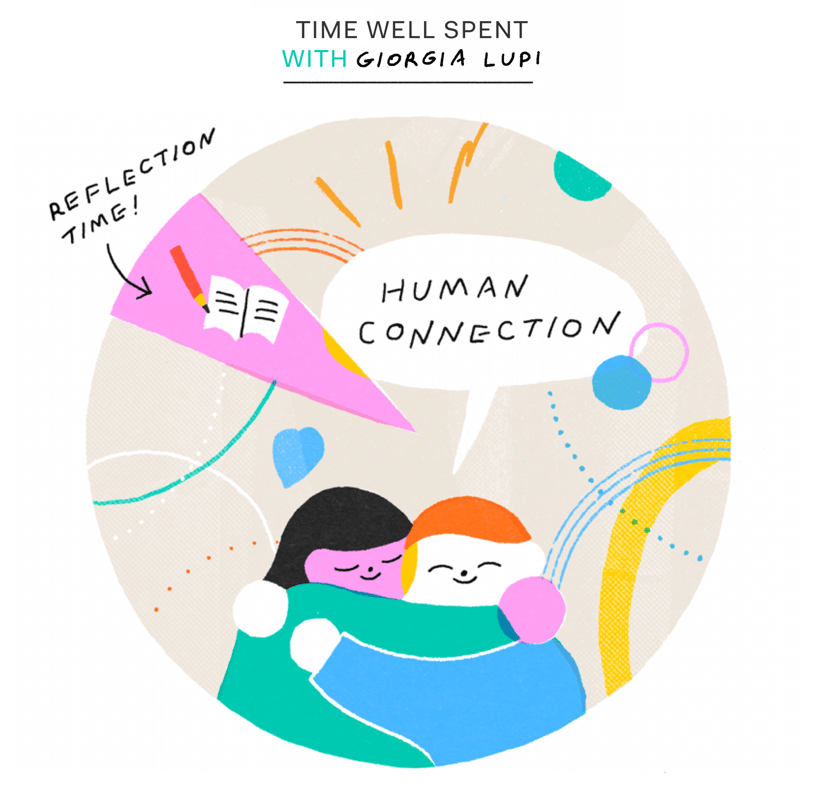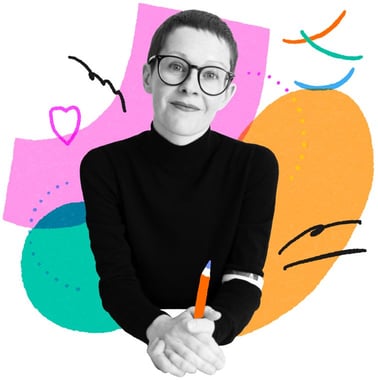Giorgia has used data as a tool to explore and illustrate concepts of time through a mix of analog, handwritten, and digital methods. In her pen-pal-data-project-turned-book Dear Data, she and London-based data designer Stefanie Posavec sent each other handwritten postcards tracking their personal data for a year, and became long-distance friends in the process. Giorgia has also used data as the foundation for designing a clothing collection, a musical collaboration, digital maps, visualizing the lives of famous painters, and more.
We spoke with Giorgia about how collecting data and making it visual can be a powerful tool for better understanding ourselves and each other.
Giorgia, you have used data and design to represent time in a variety of ways through collaboration. How are data and collaboration both useful tools for revealing and representing the passage of time in our lives?
Data collection — the act of noticing, observing, and recording even the more mundane aspects of your life one subject at a time — is a beautiful tool to help us punctuate our lives and to help us get in closer touch with ourselves.
Collaboration is at the core of how I function as a designer. I have worked with a team of designers and developers for the past 15 years, initially at Accurat — the company I co-founded in 2011 — and now at Pentagram. I came to realize that my idea of “success” for a project depends not only on the goals I am trying to achieve and on how the project is received, but especially on the person or group of people I'm collaborating with. Especially for self-initiated projects, a collaborator whose work you respect is a great help to keep yourself accountable and get through the project even when you feel overwhelmed and would like to give up.
When I look back at the projects I have worked on, what feels most successful are the experiences where, by means of working with other talented people, I could experiment, venture out of my comfort zone, and push myself to places I couldn’t imagine on my own.
Collaborations are necessary for designers to grow, to question themselves, to discuss all their ideas, and to avoid “getting married” with the first ones they have. I have also learnt that I love sharing the results of a project (its publication moment and the hopefully positive response it triggers); it's one of the best outcomes of a work relationship!
“Data collection — the act of noticing, observing, and recording even the more mundane aspects of your life one subject at a time — is a beautiful tool to help us punctuate our lives and to help us get in closer touch with ourselves.”
At the end of 2020, the cover of The New York Times’ “At Home” supplement featured your work, My 2020 in Data (So Far), which tells the story of your pandemic year in data: the firsts, the lasts, and the various ways you spent your time. What surprised you most when you looked back at your year in this way?
If we think about the past year, many of us might have the feeling that nothing happened in our mostly locked-down year, that the time hasn’t passed and that every day looks equal to the day before. I reflected on my past year in data, where, through surveying data from my calendar, my diary, my text conversations, and more, I built a visual timeline for myself, tracking the “last” time I did something before the pandemic hit and the “first” time I did something new as we started to emerge from lockdown.
Reading my journal for the year, it struck me how probably all of us can recall the “last time” we took the subway, sat at a bar counter, saw a dear friend. But we all likely have many “first times” on our calendars as well, slowly regaining a sense of freedom and punctuating our mental timelines. Choosing to pay attention to these moments help us visualize and appreciate the passing of time, even when it really doesn’t feel like it moves.
“Choosing to pay attention to these moments help us visualize and appreciate the passing of time, even when it really doesn’t feel like it moves.”
What’s your advice to others who want to start tracking their personal data, whether using the Data Selfies rubber stamps that you designed or other methods?
Take 10 minutes at the end of your day for reflecting and journaling on it in a systematic way.
For example, every evening I write my answers to these questions in order:
- What was the highlight of my day?
- What did I feel happy about?
- What was missing?
- What did I like about myself?
- What would the best day have looked like?
- What was I worried, anxious, or sad about?
- Thoughts on how to improve the aspects I didn’t like
- Note or context: (Here I generally note if something special happened.)
It is the easiest form of data collection, and over time it can become a sweet ritual for the end of your day. Most importantly, it can help you pay attention to how you spend your time and where you focus your energies. It helps to create awareness and to get you more in tune with yourself. Ultimately, it helps us to appreciate the small details of our lives more.
From here on, every form of active data collection can happen: Start with what you are curious to explore about yourself and systematically collect data over time about it. It's all about how you set up the "questions.”
The aspect of visualizing your data comes after. It doesn’t have to be fancy. It’s about creating rules for yourself, such as: If ________(this) occurs in the data, then I will draw _______ (a color, a shape, a length).
Curious to try this practice yourself? Check out Giorgia’s Worksheet!
“It can help you pay attention to how you spend your time and where you focus your energies. [...] Ultimately, it helps us to appreciate the small details of our lives more.”
In a perfect world, how would you use your time?
Creating. Making. Traveling. And spending as much of the remaining time with the people I love.
Do you identify with the concept of flow? If so, what happens to time when you’re in the state of flow?
I do, even though in these days filled with video calls it feels a little harder to reach. Flow is, for me, the feeling that I am completely involved in what I am doing for its own sake. Flow is when I feel energized and focused, driven, and excited. Flow is when I am able to stop thinking and just be making.
What’s one non-negotiable thing you always make space for in your life? What’s something you’d like to do less of?
A (hopefully long) walk every day is non-negotiable for me. Worrying about what I can’t control is something I’d definitely like to spend less time on.
“Flow is when I feel energized and focused, driven, and excited.”
Imagine you’re reflecting at the end of a day or other period of time where you felt that your time was well spent. What did you do? How did it feel? How much time did you spend doing it?
It’s the time I spend with the people I love. Especially in this past year I have been missing seeing my family (my mom) and my close friends very much. Time well spent is time nourishing meaningful human connections. Every time I do it, even just spending evenings and weekends with my partner now, I feel fulfilled. I feel full and nourished. Ideally I would be with the people I love all the time, even just sharing the room as we go about doing different things.



